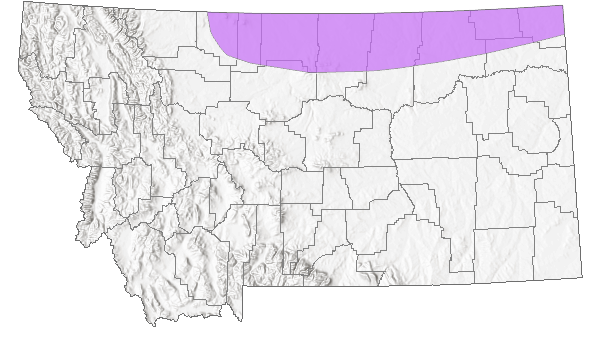View in other NatureServe Network Field Guides
NatureServe
Montana
Utah
Wyoming
Idaho
Wisconsin
British Columbia
South Carolina
Yukon
California
New York
Sandy Tiger Beetle - Cicindela limbata
State Rank Reason (see State Rank above)
Species appears to have limited distribution in Montana, but no occurrences are known.
General Description
[From Acorn 2001; Pearson et al. 2006] Length 10-12 mm. Most populations (except the most northern Canadian populations) characterized by a coalescence of maculations so that the elytra are mainly white with a dark triangle down the midline, except for a few small dark patches. Dorsal coloring on head, thorax, elytral patches reddish brown in the north, greenish in the south; undersides coppery green to metallic purple. Underside and thorax thickly covered in whitish hairlike setae, forehead hairy. Legs dark. C. l. nympha, the subspecies in northern Montana and adjacent regions, generally fits the above description, with a thin dark patch posteriorly and sometimes a tiny dark patch anteriorly on the elytra.
Phenology
Adults emerge the first half of August to late September, hibernate, reemerge the following spring (April to July); larvae take 2-3 years to mature in most areas (Acorn 2001; Larochelle and Lariviere 2001; Pearson et al. 2006).
Diagnostic Characteristics
Best determined by combination of smaller size, mostly white elytra with few maculations, dark legs, and occurrence in sandy habitat.
Species Range
Montana Range
Range Descriptions

 Native
Native
Range Comments
C. l. hyperborea across northern Alberta, northern Saskatchewan, southern Northwest Territories; C. l. nympha from central Alberta east to southern Manitoba, south to northern Montana, North Dakota; C. l. limbata from southern Wyoming and northern Colorado east across southern South Dakota and Nebraska (Pearson et al. 1997; Acorn 2001; Pearson et al. 2006). In Montana, found in the northern tier of counties bordering Canada east of the mountains.
Migration
Non-migratory. Not a strong flier (Larochelle and Lariviere 2001).
Habitat
For C. l. nympha: sand dunes, sand hills, blowouts, roadsides, roadcuts, sandy lake shores; open ground, well-drained, bare or sparsely vegetated soil (Hooper 1969; Acorn 2001; Larochelle and Lariviere 2001; Pearson et al. 2006).
Food Habits
Larvae and adults carnivorous; the larvae sit-and-wait predators in burrows, the adults actively pursue prey on the ground surface (Acorn 2001; Pearson et al. 2006).
Reproductive Characteristics
Mating June to July, copulating pairs often seen partially buried in sand. Larvae live in burrows 17.5-42.5 cm deep for about 2 years, inactive in summer and overwinter as larvae (as well as adults), pupate in August and September, emerge as adults in August and September, adult lifespan 1 year (Larochelle and Lariviere 2001; Pearson et al. 2006).
References
- Literature Cited AboveLegend:
 View Online Publication
View Online Publication Acorn, J. 2001. Tiger beetles of Alberta: killers on the clay, stalkers on the sand. The University of Alberta Press, Edmonton, Alberta. 120 p.
Acorn, J. 2001. Tiger beetles of Alberta: killers on the clay, stalkers on the sand. The University of Alberta Press, Edmonton, Alberta. 120 p. Hooper, R.R. 1969. A review of Saskatchewan tiger beetles. Cicindela 1(4):1-5.
Hooper, R.R. 1969. A review of Saskatchewan tiger beetles. Cicindela 1(4):1-5. Larochelle, A and M Lariviere. 2001. Natural history of the tiger beetles of North America north of Mexico. Cicindela. 33:41-162.
Larochelle, A and M Lariviere. 2001. Natural history of the tiger beetles of North America north of Mexico. Cicindela. 33:41-162. Pearson, D. L., T. G. Barraclough, and A. P. Vogler. 1997. Distributional maps for North American species of tiger beetles (Coleoptera: Cicindelidae). Cicindela. 29(3-4):33-84.
Pearson, D. L., T. G. Barraclough, and A. P. Vogler. 1997. Distributional maps for North American species of tiger beetles (Coleoptera: Cicindelidae). Cicindela. 29(3-4):33-84. Pearson, D.L., C.B. Knisley, and C.J. Kazilek. 2006. A field guide to the tiger beetles of the United States and Canada: identification, natural history, and distribution of the Cicindelidae. Oxford University Press, New York, New York. 227 pp.
Pearson, D.L., C.B. Knisley, and C.J. Kazilek. 2006. A field guide to the tiger beetles of the United States and Canada: identification, natural history, and distribution of the Cicindelidae. Oxford University Press, New York, New York. 227 pp.
- Additional ReferencesLegend:
 View Online Publication
View Online Publication
Do you know of a citation we're missing? Bousquet, Yves. 2012. Catalogue of Geadephaga (Coleoptera; Adephaga) of America north of Mexico. ZooKeys. 245:1-1722.
Bousquet, Yves. 2012. Catalogue of Geadephaga (Coleoptera; Adephaga) of America north of Mexico. ZooKeys. 245:1-1722.
- Web Search Engines for Articles on "Sandy Tiger Beetle"
- Additional Sources of Information Related to "Insects"





